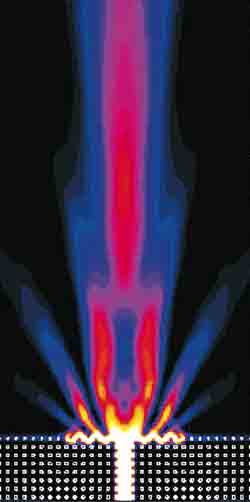Light at the End of the Tunnel
Photonic crystals promise to shrink the optical devices used in telecommunications by confining light more compactly than current designs do. But getting light in and out of them has been a challenge: once light leaves a photonic crystal it sprays out in all directions, and much of it is lost. Two independent reports, in the 15 March Physical Review B and the 19 March PRL, describe using the surface of the photonic crystal as a kind of antenna to beam the emitted light in a single direction, like a flashlight. Improvements on this technique may help photonic crystal devices to efficiently swap light signals with conventional fiber optic devices.
One type of photonic crystal consists of a two-dimensional array of microscopic cylinders. Light within a forbidden range of wavelengths can’t propagate through the array, so if a row of cylinders is omitted, the light will be trapped in the missing row. The resultant waveguide can be less than a wavelength wide, much narrower than traditional structures. Researchers have designed a smorgasbord of devices for manipulating light with such waveguides, including sharp bends, splitters, and filters, with the goal of creating circuits of light inside a chip.
One difficulty with these devices is that confining light more tightly always makes it spread over a wider angle when it emerges, thanks to diffraction. So only a small fraction of that emerging light can be collected by a subsequent fiber or lens. In 2002 a team succeeded in restricting the spreading of light emitted from a narrow slit in a metal film [1]. The trick was to make shallow grooves in the metal next to the slit. The light generates an electron wave moving along the metal surface, and each groove radiates a little light as the electron wave passes. Since the grooves, or “corrugations,” extend over an area much wider than the original slit, diffraction doesn’t spread the light so broadly.
Esteban Moreno, of the Swiss Federal Institute of Technology (ETH) in Zurich, Switzerland, and the Universidad Autónoma of Madrid, says that his Phys. Rev. B co-authors had previously modeled the metal films. “We just translated that work to the photonic crystals.” Moreno and his colleagues ran computer simulations of their new photonic crystal design but haven’t yet constructed it. First, to channel light to the surface, they shrank the diameter of cylinders in the final row, in effect creating a waveguide at the surface. Then, to induce the light at the surface to radiate its energy into a beam just a few degrees wide, they slightly displaced every other cylinder along this row to create the needed corrugation.
Varid Sandoghdar of ETH says his team had already measured unexpectedly narrow-beam emission from the end of a real photonic crystal waveguide in 2001. But it wasn’t until the metal results came out two years ago that “it kind of clicked that they were related.” These researchers used a so-called triangular lattice of cylinders, where the cylinders of each row align with the gaps between cylinders in neighboring rows. The end of such a lattice is automatically corrugated, which may partly explain the effect. The team also ran computer simulations that show narrow emission occurs when they slice the lattice at some locations but not at others.
Neither team has yet determined what fraction of the light from within the waveguide can ultimately be funneled into the external beam, rather than being reflecting back into the crystal. Nonetheless, “this is very exciting,” says John Pendry of Imperial College in London. “Essentially, the structure introduced onto the surface is a lens,” but one which focuses by diffraction.
–Don Monroe
Don Monroe is a freelance science writer in Murray Hill, New Jersey.
References
- “Beaming Light from a Subwavelength Aperture, ” H. J. Lezec, et al., Science 297, 820 (2002)
More Information
Focus story from 2003 describing the theory of narrow-beam transmission from a narrow slit
related Focus story from 1999



